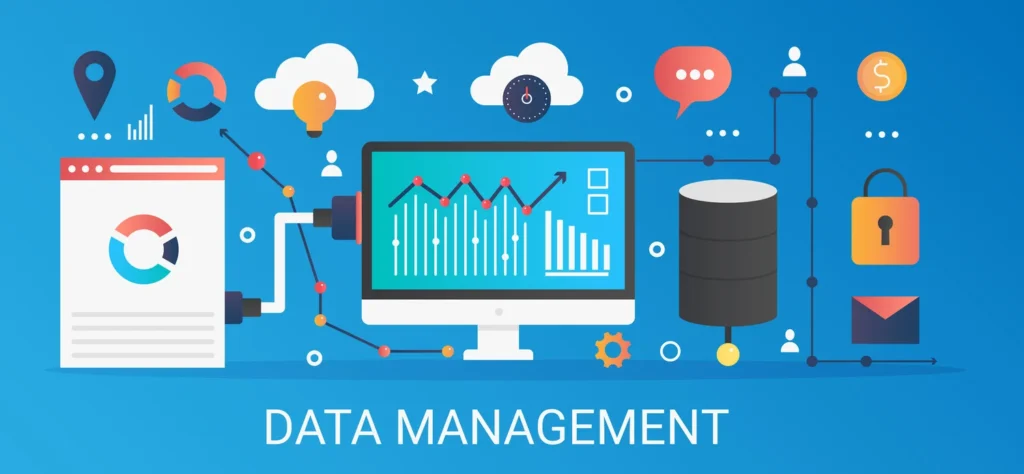Data is everywhere in business these days, especially since more and more things are becoming digital. This is why small businesses need to be good at managing data to be successful. If you know how to manage your data correctly, you can make smart choices about the next step you should take for your small business.
It might be tough for small businesses to start keeping track of their data. Many small and medium-sized businesses may not have a lot of resources, like money or staff. You can begin with a small effort, though. Do not think that managing data always means having a big, complex server or a data cloud system. It can begin with something as simple as keeping track of your inventory or writing down the transactions you make every day.
So, don’t overthink any sophisticated system; instead, start with our 7 data management tips for small businesses.
Data Management Tips for Small Businesses
If you’re a small business, you may not have any plans for how to handle your data at all.
However, you can start small by writing down your goals and making a plan for how to handle your data. Then you can think about other things about your data, like keeping it safe, controlling who can see it, and making backups.
The last step is to start teaching your team how to use your data management strategy. You may also want to think about buying software for a data management system. So here we compile 7 data management tips with the help of the Soma Technology Group blog post, so you can start laying out some strategies for your small business.
1. Identify your data management goals
A good data management strategy should have goals before you start organising your data. For example, if your goal is to improve customer satisfaction, you may want to focus on collecting and analysing customer feedback data. Once you have identified this goal, you can start implementing processes to assure that this data is collected, stored securely, and easily accessible to the relevant team members.
This may involve setting up a customer relationship management system and training your team on how to use it effectively.
Here are some examples of data management goals:
- Improve data quality
- Enhance data security
- Integrate data
- Implement data governance
- Optimise data storage
- Manage data lifecycle
2. Create a data management process
After you have your goals, the next thing is to lay out the strategy for processing your data. This involves creating a step-by-step plan for how data will be collected, cleaned, stored, and analysed. It may also include assigning roles and responsibilities within your team to ensure that the process runs smoothly and efficiently.
Additionally, it is important to establish clear guidelines for data access and usage to maintain data security and compliance with regulations. Regular monitoring and evaluation of the data management process will help identify areas for improvement and ensure that your goals are being met effectively.
You can start making your own data management system by learning about the idea of Data Lifecycle Management (DLM). Reading our article, “Data Management Lifecycle: What It Is and the 8 Stages of the Process“, will help you understand what that method means and how it works.
3. Prioritise security and compliance
Data security and compliance are important for small businesses to show that they have done what they need to do to keep customer data safe. Customers will still trust and stay loyal if you do this. Compliance is also important because it keeps businesses from getting fined or punished by regulators for not meeting certain standards or requirements.
For example, a small online retail business can implement DLM by regularly backing up customer data, encrypting sensitive information, and regularly reviewing and updating their security measures. This will help protect customer information from data breaches and cyberattacks. Additionally, businesses can also consider implementing a data breach response plan to quickly address any security incidents that may occur.
4. Manage data access
Managing who can access your data is one of the most basic ways to keep your data safe. Adding an extra layer of security with multi-factor authentication can help make sure that only authorised users can access sensitive data. Small businesses can also quickly find any suspicious activity and deal with possible security threats by keeping an eye on data access logs on a regular basis.
Managing who can login to your business’s social media account is a simple way to start. Ensure that only authorised individuals, such as you and your social media team, can access that.
Next, use multi-factor authentication to make sure you know what every new device login is. Later, check the data access logs often to make sure no one else is logging into your social media account without your permission.

5. Do backups regularly and prepare a data recovery plan.
After a while, your database may begin to grow and expand. While the most recent data is important for making short-term decisions, older data can help you see the big picture and gain insight into your business’s lifecycle.
This is why it’s important to back up data. For a small business, you might want to do it with both an online and offline approach. You can store your data on your own hard drive and in the cloud at the same time.
When you start making backups as a habit, the next thing you must think about is your data recovery plan. We never know if a hardware failure, natural disaster, or malicious attack will happen. Having a data recovery plan in place will ensure that you can quickly recover and resume operations in the event of any unforeseen circumstances.
Regularly testing your data recovery plan is also crucial to identify any potential issues and make necessary adjustments.
6. Train employees in data management
Teaching your employees about cyberattacks can help you keep sensitive information safe. Training also helps workers understand what part they play in the company’s overall data strategy and how they can help it succeed.
So, teach them basic data management skills like how to properly gather, handle, organise, protect, and store data. It would also be helpful to teach them how to spot common phishing attempts and not open attachments or click on links that look sketchy.
7. Invest in reliable data management system software
The last thing you can do to improve your strategy is to buy reliable data management system software. The reason for this is that you should start your data management with a culture that is focused on data. If your company doesn’t care about data, you won’t need any data management software or even the system itself.
A dedicated system can help small businesses run more smoothly by automating data-related tasks, cutting down on manual data entry, and improving the accuracy of data. Overall efficiency and productivity go up because workers don’t have to spend time managing data by hand. Instead, they can focus on tasks that add value.
Which Database Software is Best for Small Business?
It’s very important to choose the right database for your small business. There are different databases for different needs, and the one you choose will depend on things like the size and complexity of your data, as well as how your business works. There are a few things you should think about before you choose that database software:
- Scalability: When your business grows, the software should be able to handle more data and more users without slowing down.
- Robust security: Protect private business and customer data with high-tech security features like data encryption and secure access controls
- Compatibility with spreadsheet software: Using this feature makes working on data easy.
- Intuitive design: The software should have an easy-to-use interface so that training time is kept to a minimum.
- Efficient customer support: Reliable and easy-to-reach customer service that can fix software problems quickly cuts down on downtime.
- Integration capabilities: It should be able to work with the business tools you already have, so that data flows smoothly and processes run smoothly.
- Insightful analytics: Data-driven decisions for business growth help you get deep insights from analytics.
Now that you know what to think about when picking a data management software, you can start choosing one. There are many kinds of data management software, and each one can be used for different things. First, look at the list below of the most popular data management system software and pick one that works for you.
MySQL: MySQL, a popular open-source relational database management system, is known for its reliability and ease of use. It is suitable for businesses that require structured data storage and seamless integration with various applications.
MongoDB: For businesses dealing with large volumes of unstructured data, MongoDB, a NoSQL database, offers scalability and flexibility. Its document-oriented approach makes it a preferred choice for applications with evolving data structures.
Microsoft SQL Server: For businesses with a focus on Microsoft technologies, SQL Server provides an enterprise-grade solution. It offers advanced features, robust security measures, and seamless integration with other Microsoft products.
Firebase: Firebase is an excellent choice for small businesses with a focus on real-time data synchronisation. As a cloud-based solution, it facilitates collaborative work and ensures that the latest data is available to all team members instantly.
This concludes the list of small business data management tips. As your business grows, you may need to take a more strategic approach to data management. You can begin learning about enterprise data management (EDM) through our article, “Enterprise Data Management: Benefits, Key Components, and Examples“.
Conclusion
Finally, by implementing efficient data management practices, small businesses can acquire a competitive advantage. An all-inclusive data management strategy must include robust security measures, regular data backups, well-organized data classification, and staff training. Following these guidelines, small businesses can use their data to their advantage, allowing them to make better decisions and achieve long-term success.
Now, are you ready to take your data management to the next level?
Nexalab data visualisation service can help you make sense of your data, turning it into valuable insights that drive strategic decisions.
We offer the data management tools for you, including Interactive Dashboards, Data Integration and Aggregation, Advanced Analytics and Forecasting, Automated ETL Workflows, Customised Visualisations, Real-time Data Updates, Data Quality and Validation, and Security and Compliance.




